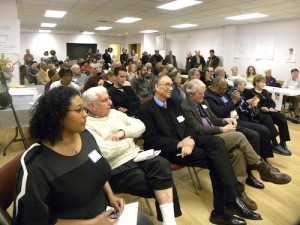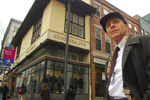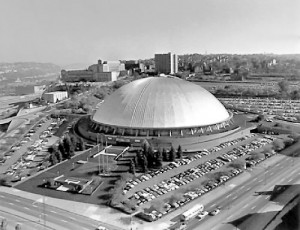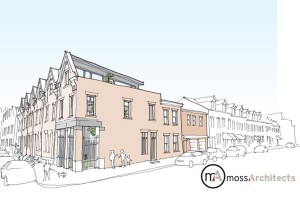
Category Archive: Preservation News
-
Now Available: August Wilson: Pittsburgh Places in His Life and Plays
 More than 200 people attended the book-signing celebration hosted by the Pittsburgh History & Landmarks Foundation, Historic Hill Institute, and Hill Community Development Corporation on Saturday, February 26 at Ebenezer Baptist Church in Pittsburgh’s Hill District. “This guidebook to places associated with playwright August Wilson’s life and work is the result of the cooperative efforts of many people,” said Louise Sturgess, executive director of Landmarks, “and its power is not to be underestimated in terms of its substance and impact.”
More than 200 people attended the book-signing celebration hosted by the Pittsburgh History & Landmarks Foundation, Historic Hill Institute, and Hill Community Development Corporation on Saturday, February 26 at Ebenezer Baptist Church in Pittsburgh’s Hill District. “This guidebook to places associated with playwright August Wilson’s life and work is the result of the cooperative efforts of many people,” said Louise Sturgess, executive director of Landmarks, “and its power is not to be underestimated in terms of its substance and impact.”Lead donors Kenya Boswell from BNY Mellon Foundation of Southwestern Pennsylvania and Gerry Kuncio of the Pennsylvania Historical and Museum Commission offered brief remarks, along with the authors Laurence A. Glasco, Christopher Rawson, Kimberly C. Ellis, and Sala Udin. The authors and PHLF presented complimentary books to high schools, colleges, and libraries in the city and county.
The guidebook was supported by a Preserve America grant from the National Park Service, administered under the Preserving African American Heritage in Pennsylvania program of the Pennsylvania Historical and Museum Commission. The Multicultural Arts Initiative and 75 PHLF members and friends also contributed to the guidebook.
August Wilson is one of America’s great playwrights. He lived in Pittsburgh from his birth in 1945 to 1978, when he moved to St. Paul, MN, and later to Seattle, WA. He died in 2005 and is buried in Pittsburgh. Wilson composed 10 plays chronicling the African American experience in each decade of the twentieth century––and he set nine of those plays in Pittsburgh’s Hill District. He turned the history of a place into great theater.
“It’s very exciting to be part of an excellent project that results in a resource that will help make Wilson’s life and work more accessible to the public, become the basis for public tours, and encourage people to care for and preserve the Pittsburgh places connected with the African American playwright,” said Gerry Kuncio.
To order a book ($8.95 plus sales tax), click here.
-
Fairview Park in Delmont Gains National Historic Status
Thursday, February 24, 2011By Laurie BaileyFairview Park in Delmont Gains National Historic Status
It’s important for retired history teacher Barbara Calloway that her children and grandchildren realize the impact of Salem Township’s Fairview Park on her own family and a generation of area African-Americans.
“They really can’t imagine the whole segregation thing. It’s part of our integrity, our history and part of who we are,” she said.
The park was selected earlier this month to be on the National Register of Historic Places. It was developed in 1945 by the Monongahela Valley Sunday School Association — a group of African-American churches from Westmoreland and Allegheny counties. At a time when segregation restricted access to other public amusement parks, Fairview Park was a place the African-American community could call its own.
“The designation is a recognition of what the people who founded the land had to go through,” Fairview Park Association president Ernest Jackson said.
The idea for a safe, welcoming place for African-American families, many from urban communities, to have fun and fellowship was actually conceived in 1918, Mr. Jackson said.
“No banks were lending money for land to black folks at that time,” he said. A banker himself, Mr. Jackson is vice president of operations for Dollar Bank.
People put up their own cash, even mortgaged their homes to develop the 100 acres of land where a roadside gas station and restaurant once stood along Route 22. “It wasn’t an easy transaction,” Mr. Jackson said.
By the 1940s and 1950s, the park established itself as the first African-American-owned amusement park and the place to go for church picnics and other gatherings. In its heyday, it featured a roller coaster and merry-go-round for small children, a swimming pool, softball fields, playground equipment, petting zoo and even hot air balloon rides.
“We took our picnic baskets and visited. The church picnic was the highlight of the year,” said Mrs. Calloway, of Point Breeze. Most churches had buses to transport those without cars to the Westmoreland County park.
“If you trace the history of the Civil Rights movement, you could determine when the park was most popular,” Mr. Jackson said.
Attendance started to decline in the late 1960s with the Civil Rights movement.
As money was needed throughout the park’s history, parts of the land were sold, including 33 plots that created the first black community in Salem Township. Part of the land was sold to pay real estate taxes — a cost that should have never occurred, Mr. Jackson said. Because the proper paperwork had not been filed, tax-exempt, non-profit status wasn’t official until 1998.
Now the association’s goal is to develop the park, which is still functional and used by a variety of groups. Costs for maintaining the existing 52 acres come entirely from donations, mainly from the dozen or so churches actively involved in the association. Volunteers cut the grass and do repair work.
But significant funding is required to meet the park association’s short term plans for updating the existing three shelters and bathroom facilities, playground equipment and ball field. The group is hoping to find someone to offer expertise in grant writing, Mr. Jackson said.
Along with its new national historical status, the park is eligible for consideration in federally assisted projects and qualifies for federal grants for historical preservation when funds are available, according to the website for the National Register of Historic Places: www.nps.gov/nr.
The association has a dream of further developing the park into a retreat center, providing facilities for church groups and businesses.
“With over 50 acres of land, there are many things we could do,” Mr. Jackson said.
But for now, as in the early days, church picnics successfully prevail, introducing today’s children to old-fashioned traditions like sack races, baking contests and bingo.
“They are things that kids don’t do now, but once they catch on, it gets competitive,” Mr. Jackson said.
-
Grant to Help Return Saxonburg Main Street to 1850s
Thursday, February 10, 2011By Karen Kane, Pittsburgh Post-GazetteSaxonburg’s Main Street program manager says he’s feeling “pretty blessed” by the news last month that the Pennsylvania Department of Transportation had come through with a $1.4 million grant.
The money was both needed and expected. But, Raymond Rush said he was happy it was all official.
“We’ve been blessed by PennDOT and beyond,” he said.
Design and engineering work is under way for reconstruction of both sides of Main Street — a four-block section of the street that spans about 2,200 feet from Butler Street to Rebecca Street. Those costs are being covered by a $373,027 grant awarded in May by the Department of Community and Economic Development.
Now, PennDOT has come through with a $1.4 million grant for construction of half of the project: from Pittsburgh Street west to Rebecca Street.
The work will involve reconstructing sidewalks and curbs, and installing landscaping. Street lights that replicate old-style German lights will be installed.
The first half of the project is to be under way in the second half of the year with finishing work in the first quarter of 2012, Mr. Rush said. Sometime early in 2012, he’s expecting to hear that PennDOT is coming through with the rest of the funding. The total project cost is estimated at $2.4 million. The second half of the project would start during the 2012 construction season. Mr. Rush predicted the job would be completed within a year’s time.
He credits receipt of the grants to a partnership between the borough and the John Roebling’s Historic Saxonburg Society Inc., a nonprofit group that sponsors the Main Street program. The society is named for the town’s founder who invented wire cable and is famous for bridge design. One of his most notable projects was the Brooklyn Bridge in New York.
Saxonburg’s Main Street is an official historic district on both state and national levels. There are 52 historic buildings in the four-block project area, including Mr. Roebling’s home. A native of Germany, he designed the borough.
Mr. Rush said the reconstruction project will maintain the borough’s historic look while modernizing the infrastructure.
“It will bring the 1850s look into modern society,” he said.
-
Deal Reached to Save Historic Franklin County House
Tuesday, February 08, 2011By Len Barcousky, Pittsburgh Post-GazetteDeal Reached to Save Historic Franklin County House
A history-loving physician has worked out a deal to save an 18th century home in Mercersburg.
Dr. Paul Orange said today the William Smith House will be taken apart piece by piece over the next several weeks and reassembled on a new site elsewhere in the Franklin County community.
The future of the building has been in question since the structure and land on which it stands were acquired two years ago by a local volunteer fire company. The MMP&W Fire Co., which has its headquarters and garages next door to the house on Main Street, bought the property for expansion and had announced plans to demolish the building.
That news resulted in the creation of a citizens group, the Committee to Save the Justice William Smith House. Members say that events planned in the stone Ulster-style cottage in 1765 resulted in the earliest opposition to British rule in the American colonies and laid the groundwork for the Second Amendment to the U.S. Constitution. That amendment guarantees the right to bear arms.
Dr. Orange, who has a family medical practice outside Chambersburg, estimated that the relocation project will cost as much as $250,000. He has agreed to fund at least $50,000 of that amount.
The first steps involve removing 19th- and 20-century additions to the structure, carefully taking apart and numbering stones and timbers from the core of the building and arranging for storage nearby. That process is likely to take several weeks, he said.
No decision has been made on where the house will be rebuilt. Several suitable properties are vacant along and near the borough’s Main Street.
Mercersburg is about 150 miles southeast of Pittsburgh.
-
Around Town: Point of Realism Interferes With Preserving Arena
Tuesday, February 08, 2011By Brian O’Neill, Pittsburgh Post-GazetteAround Town: Point of Realism Interferes With Preserving Arena
The Civic Arena can still pack ’em in. It was standing-room-only last week at the Pittsburgh Historic Review Commission meeting on Ross Street, just down the hill from the vacated hockey palace.
Some very smart people made a polished and impassioned presentation that showed the 49-year-old Igloo to be an architectural superstar, an engineering marvel and the symbol of Pittsburgh’s Renaissance, rising just as the city’s skies were clearing.
What nobody offered, though, is what practical use it has now. In the past quarter-century, three multipurpose arenas of ascending size — the 5,400-seat Palumbo Center, the 12,500-seat Petersen Events Center and the 19,000-seat Consol Energy Center — have been built within two miles of the place.
This city needs another arena like it needs a hole in the Hill.
To be fair, it wasn’t the job of preservationists this day to offer a practical new use for the empty building. The question was whether the Civic Arena should be designated a historic structure.
But if the commission votes next month to grant historic designation (preliminary approval last month is no guarantee), that would prevent the city-county Sports & Exhibition Authority from demolishing the arena. That would muck up the Penguins’ development plans for the 28-acre site, and the most prominent Hill District leaders don’t want those plans blocked. Residents have been waiting 50 years to get their neighborhood back.
Both preservationists and those who want to see office buildings, stores and about 1,200 new homes built at the site agree on one thing: The way the Hill District was treated when the arena site was cleared in the 1950s was a civic crime. About 1,300 buildings, 400 businesses and 8,000 lower Hill residents got the heave-ho. Promises of better housing were never kept, and the highway ditches and largest park-for-pay lot in Western Pennsylvania are the neighborhood amputation scars.
Rob Pfaffmann, the Downtown architect who has spearheaded the Reuse the Igloo campaign, suggests that keeping the building can help future generations remember that painful history. He quoted the native son who did the most to celebrate the neighborhood, the late playwright August Wilson, who said, “My plays insist that we should not forget or toss away our history.”
Mr. Pfaffmann even broke out a Rick Sebak video on the arena. (The video player, like the Igloo’s acoustics, went awry shortly.) But neither Mr. Pfaffmann nor the city’s premier architectural storyteller, Franklin Toker, could persuade Hill leaders that this mammoth steel assemblage would be anything but a humongous kink in plans to reknit the neighborhood into Downtown.
City Councilman Dan Lavelle said the commission’s mission statement also speaks to the preservation of neighborhoods. He hoped it would pay attention to community residents rather than those with fond memories of coming to the lower Hill “to listen to the Beach Boys at the expense of those who lived there.”
This “case study of urban renewal gone wrong,” which isolated and divided the Hill, is “not the sort of history we wish to preserve,” Mr. Lavelle said. Preserving it, he said, would be like flying Confederate flags on state buildings in the South.
Paying $50,000 a month to maintain it, or tens of millions of dollars to modify it for a new use, would not be a smart move for a strapped city, he concluded.
What do you do with a spare arena? Modification plans all seem a bit like getting a bear to ride a bicycle. It can be done, but that’s not really what either bears or bicycles are for.
What about saving part of it? TV actor David Conrad, in a videotaped presentation, said he understood why neighborhood residents want the arena erased, but saving a piece could “transform an insult into pride.” Preservation of a remnant would be akin to the iconic murals of saints, he said, which often show the martyred figures holding the very weapons that killed them.
Sala Udin, who formerly held the council seat in the Hill, didn’t think the neighborhood would oppose a “remnant that stayed as some kind of icon.” But full preservation would block development plans.
Penguins President David Morehouse said preserving a remnant, as was done with the Forbes Field outfield wall, is possible, but “you can’t have half of a dome in the middle of your development.”
The Hill’s comeback has to be the primary goal. That started more than 20 years with the hugely successful Crawford Square townhouse development just east of the arena. With gasoline prices soaring, building another 1,200 new homes in the heart of the region is about the best news a shrinking city could get.
-
Demolition of Iron City Ice House OK’d
Thursday, February 03, 2011Pittsburgh Post-GazetteThe Historic Review Commission Wednesday approved demolition of the original ice house at the Iron City Brewing Co. in Lawrenceville, one of a collection of buildings on the site that has the city’s protection of historic status.
The one-story building, which sits behind the original brewhouse, is dilapidated. Brewery CEO Tim Hickman said he would not consider an estimated $750,000 it would take to restore it.
Acting commission chair Ernie Hogan said that the Pittsburgh Historical and Museum Commission and a preservation planner advised the commission that if the building is properly documented it can be demolished without jeopardizing the rest of the site’s potential for placement on the National Register of Historic Places or the tax credits that would go with its redevelopment.
Preservationists argued against any demolition at the brewery site before completion of a master plan.
The commission also approved demolition of an unused garage in Deutschtown, to be replaced by a new Duquesne Light valve station, with pipes and conductors beneath it. The original plan to build the station in Allegheny Commons Park was abandoned after strong neighborhood outcry.
-
Row of Vacant Lawrenceville Houses Being Restored with Historic Exteriors, Custom Interiors
Wednesday, February 02, 2011
Pop City Media
Since they were left vacant in 1995, the row of five historic brick houses on 48th Street, between Hatfield and Butler Streets, in Lawrenceville have fallen into terrible shape. With creative design and green construction, the homes are being restored to look the way they would have when they were built in the 19th century, but with customized modern interiors.
The City of Pittsburgh acquired the buildings, with the help of the Lawrenceville Corporation, in 2007 at very low cost using a tax lien process. After receiving proposals from many eager developers, the Lawrenceville Corporation closed on the sale last week with Botero Development, who’s principal Brian Mendelssohn lives in the neighborhood.
“They’re going to be a high quality product. We’re going to restore the exteriors using real materials, meaning real stone and real slate, and install stone steps and things like that to make them look like when they were built,” says Mendelssohn, who is working with Moss Architects on the project. The interiors will be custom-built for the aesthetic whims of the individual buyers, blending historic elements and original materials with modern features, such as stainless steel appliances, and energy efficient design aspects, like a 2-inch white rubber roof.
The homes, which are currently for sale, include four 1900-square-foot, 3-bedroom units with rear yards. Two come with 2.5-baths and the other two have 2-baths. One 1,250-square-foot unit has 2-bedrooms and 2-baths. The houses will be completed by next October and are priced between $180,000 and $265,000. A sixth building was beyond repair, but its lot will serve as a private courtyard for the $265,000 unit.
“I feel the prices are below market value for what these buildings are,” says Mendelssohn. “It will be good for the neighborhood not to start charging $300,000 for homes in Lawrenceville. You don’t want to gentrify your own neighborhood, you want to keep it what it is.”
Writer: John Farley
Source: Brian MendelssohnImage courtesy of Botero Development
-
Landmarks Foundation Waits for Word on $4 Million State Grant
By Craig Smith
PITTSBURGH TRIBUNE-REVIEW
Wednesday, February 2, 2011
Arthur Ziegler, president of the Pittsburgh History & Landmarks Foundation, surveys Fifth Avenue, Downtown, part of an area his group has earmarked for more redevelopment like its Market at Fifth project. The foundation is awaiting word on whether a $4 million state grant from former Gov. Ed Rendell's administration will come through. Gov. Tom Corbett is reviewing that grant and others like it. Keith Hodan | Tribune-Review
Arthur Ziegler Jr. likes what he sees Downtown.
Seven apartments and two retailers occupy three historic buildings that were brought back to life through a $3 million Pittsburgh History & Landmarks Foundation project dubbed Market at Fifth. More projects in the area could come to fruition if a $4 million state grant comes through.
“I am very pleased … the momentum is gaining,” said Ziegler, the foundation’s president.
Ziegler hopes to leverage the $4 million grant from former Gov. Ed Rendell to do more historic renovation work. Gov. Tom Corbett, who took office last month, is reviewing the grants, handed out in the final days of the Rendell administration through the state’s Redevelopment Assistance Capital Program, or RCAP.
The money was committed to Pittsburgh for historic building facade and core shell restoration, Ziegler said. The city appointed the landmarks foundation to carry out the work.
“It would be a great project for the city and Downtown,” said Rob Stephany, executive director of the city Urban Redevelopment Authority.
Some leaders criticized Rendell’s use of the RCAP grants, which come from borrowed money. Corbett said before he took office he would review all of the grants Rendell approved at the end of his term.
“We’re trying to go through the RCAPs as quickly as possible to make a decision,” said Kevin Harley, spokesman for Corbett.
Other areas of the country are successfully using historic renovation to spur development.
“We’re seeing a real move back to our center city — businesses and residents,” said Kevin Schwab, vice president of communications for CenterState Corp. for Economic Opportunity in Syracuse, N.Y.
Since the late 1980s, the downtown population has doubled from 1,000 to 2,000 people and 16 of 18 condos near a historic district have been sold, Schwab said. In the past decade, the revitalization has gained momentum, even during the recession, he added.
“It has all been driven by the rehabilitation of buildings that have been deemed historic,” he said.
New buildings are going up “with an eye toward being in concert” with what is already around them, he said.
If the $4 million grant for Pittsburgh survives Corbett’s review, the landmarks foundation plans to augment it with donated funds “so we can really solidify the new quality retailing we introduced with Market at Fifth,” Ziegler said.
“We would like to double (the $4 million),” he said.
The money would be used to renovate a half-dozen historic buildings scattered in the Fifth and Forbes area that have been scheduled for preservation since the days of former Mayor Tom Murphy, Ziegler said.
The Market at Fifth project restored three buildings within the Market Square historic district, including the former Regal Shoe Co., which opened in 1908.
The Regal building was designed by Alden & Harlow, then one of the city’s prominent architectural firms, responsible for the Carnegie Institute and Library additions in Oakland, and Carnegie branch libraries in various communities.
Its chief designer was one of the firm’s principals, Frank E. Alden, who in the late 1800s worked with architect H.H. Richardson supervising construction of noteworthy Downtown buildings such as the Allegheny County Courthouse and the Allegheny County Jail.


